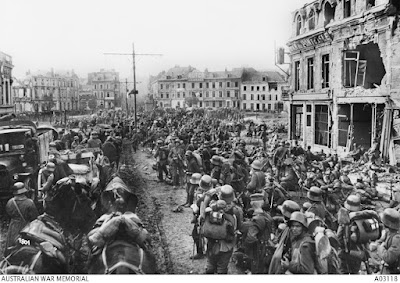 |
| Hindenburg & Ludendorff, 1918 |
A Decision to Gamble
In the fall of 1917, General Erich Ludendorff, the de facto operational commander of the German Army, began planning his 1918 campaign. Despite his successes in the past year—in particular, effectively taking the Russian Army off the board—long-term prospects were not good. The Central Powers were looking increasingly shaky and the Kaiser's army was bleeding away with forecasts for potential replacements trending sharply downward. The other principal enemies since the war's outbreak, France and Britain, of course, were facing the same pattern of losses and declining manpower. They, however, were about to tap into a nearly fathomless reservoir of new soldiers. Since April, the United States of America had been raising and training a huge army across the Atlantic, and it would be arriving in great numbers by mid-1918. Ludendorff—blind both to the declining situation on the German home front and to the massive casualties that would certainly ensue from aggressive operations—chose to mount a major offensive campaign, gambling that he could force the Allies to the peace table before the Americans became a factor. His calculations showed he would have a short-term slight advantage in the spring. Russia's revolution and collapsing war effort would free up German units in the east. Fortyeight divisions could be transferred to the Western Front, increasing German strength to 191 against 178 Allied divisions. On this small margin would the good general risk the fate of the German Empire.
Targeting the British
The next big decision was whom to target. Given his finite resources, Ludendorff recognized that he could not attack everywhere at once on the Western Front. One obvious line of thinking is that to defeat a coalition one should focus on one member and defeat it before turning on the second, now lacking any support from its ally. But whom to attack? At a war conference in Mons on 11 November 1917, Ludendorff explained his answer:
The situation in Russia and Italy will make it possible to deliver a blow on the Western Front in the New Year. . . about thirty-five divisions and one thousand heavy guns can be made available for one offensive…Our general situation requires that we should strike at the earliest moment...before the Americans can throw strong forces into the scale. We must beat the British.
But why the British rather than the French? First, it was the numerically smaller of the two main allies. Also, as commentator General David Zabecki pointed out,
An added advantage to attacking the BEF was the lack of rear area depth in the sector, with the British front lines averaging only 90 kilometers from the channel coast. On the other hand, France had proven in the 1914 Marne campaign that it could retreat deeply into the nation’s heartland if it was pressured.
 |
| German Troops Assembling for Operation MICHAEL |
But Where to Attack?
In preparation for the great German offensive of 1918, Ludendorff met at Mons on 11 November 1917 with the chiefs of staff and the principal operations planners from the army groups and the German high command (OHL). They identified several potential attack scenarios but could not decide on one. Ludendorff ordered the planners to develop fully the plans for several different courses of action, with the final decision to be made at a later date. The two most viable options at that point were operation GEORG, to be executed in Flanders by the army group of Crown Prince Rupprecht of Bavaria, and operation MICHAEL, to be executed against the British southern wing in the Somme.
Almost from the start, Ludendorff leaned toward the southern option. In describing the deliberations at the Mons conference, he later wrote:
It would seem that an attack near St. Quentin. . . Offers promising prospects. After reaching the line of the Somme between Péronne and ham it might be possible, by resting the left flank on the Somme, to advance the attack still farther in a northwestern direction, and thus eventually roll up the British front. For the success of this operation it would be especially necessary to render useless the various rail centers by means of long range artillery and bombing squadrons. That would create difficulties for the timely arrival of the enemy’s strategic reserves.
The final decision came at a planning meeting at the Aresens field headquarters on 21 January 1918. It was to be MICHAEL, but GEORG, the Flanders assault, was kept on the back burner as a deception for the time being but also as a contingency for a future initiative.
 |
| Original Concept for Operation MICHAEL |
The promise of new methods underlying Ludendorff's thinking was his belief that the German army had developed a tactical package that would create a major breach in the enemy front and allow following troops to wage a decisive campaign of maneuver—“roll[ing] up the British front"—in his words.
Source: March 2018 OVER THE TOP

Interesting point about shallowness of front and reserves.
ReplyDelete